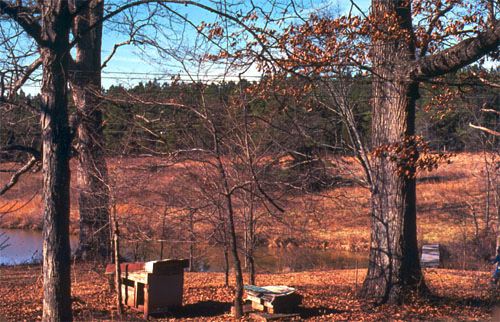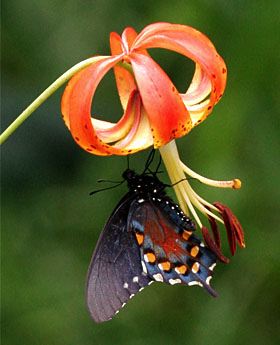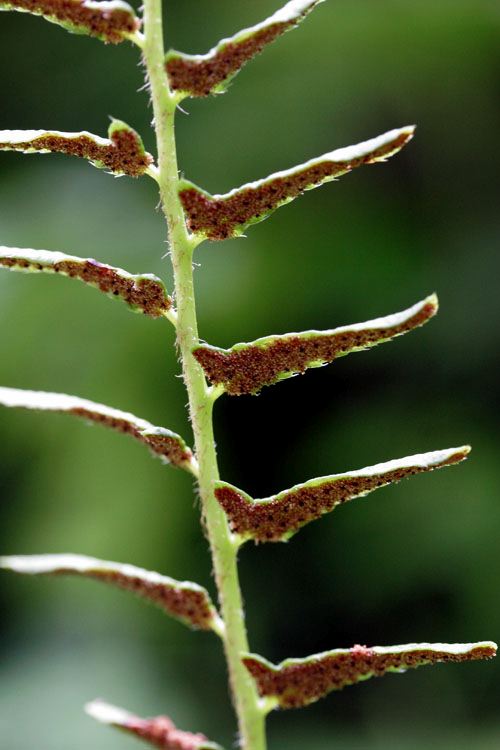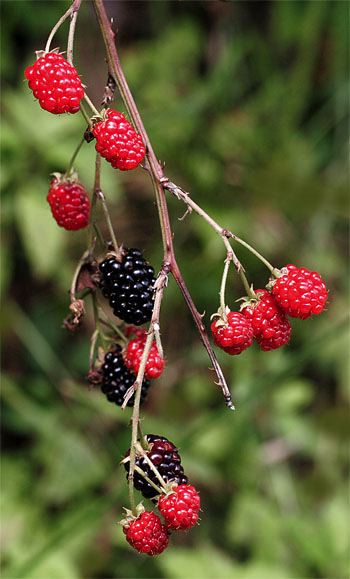|
|
|||
THIS WEEK at HILTON POND
15-21 July 2006
Installment #322---Visitor #
(Back to Preceding Week; on to Next Week)
|
NATIVE PLANTS:
THE CULLOWHEE CONFERENCE Back in 1982 when we moved to what is now Hilton Pond Center for Piedmont Natural History, the 11 acres around our old circa-1918 farmhouse were nearly all open. For perhaps a hundred years this plot had been part of a larger farmstead on which livestock were grazed and furrows were annually plowed for corn, cotton, and soybeans. With such intensive long-term use, it shouldn't be a surprise we have few wildflowers or native shrubs. After all, plowing tends of get rid of non-agricultural plants, while hungry cattle browse on almost anything that sprouts. Eventually, rootstock and seed banks disappear, and it takes a long time--maybe even forever--for native plants to re-establish.
All text & photos © Hilton Pond Center When we bought the Hilton Pond property it was about two years into natural vegetative succession; except for a few established oaks, hickories, and dogwoods (above), the landscape was mostly Broomsedge grass with a scattering of six-inch-tall Winged Elms, Sweetgums, and Eastern Red Cedars, all bordered on the north by another landowner's Loblolly Pine plantation. We had no desire to continue farming--and we were determined NOT to waste our time maintaining an 11-acre lawn--so we decided early on to let nature take its course; i.e., we laid out more than two miles of meandering trails and quit cutting everything else. In almost no time vegetation sprouted everywhere, and within a few years the property was covered by lush growth of vines, saplings, and shrubs--the vast majority being Japanese Honeysuckle, Russian Olive, and Chinese Privet. Almost 25 years ago the terms "alien," "non-native," and "invasive" weren't in our botanical vocabulary, so except for whacking back honeysuckle because it climbed and smothered trees, we allowed things to proceed in naive belief any vegetation was better than none at all. That was, in retrospect, a big mistake; for the past ten years we've spent far too much time purging our local landscape of everything EXCEPT native plants. A quarter of a century ago, however, there WERE folks who did understand the pleasures of endemic plant species and the dangers of invasives. Some of them got together to hold the first Native Plant Conference in 1984, using funds from the Tennessee Valley Authority to assemble 127 participants at Western Carolina University in Cullowhee NC. To quote the Conference Web site:
In years since, interest in native plants AND attendance at the Native Plant Conference have grown considerably. This week, we were invited by program chair Ed McDowell to talk about hummingbirds, Operation RubyThroat, and native hummer plants at Cullowhee, where we were pleased to see 361 people registered to learn how to identify, cultivate, and protect endemic plants of the southeastern U.S.
A diverse slate of speakers, workshop presenters, and field trip leaders provided lots of useful information, but some of the most thought-provoking activity came during informal one-on-one and group discussions into the wee hours of the morning. The most common question that arose in these chats was "How can we get more people interested in using native plants?"
Frankly, we've always preferred native plants to non-natives, mainly because to us endemics just "feel" like home. We're a bit put off by the garish colors of many non-native cultivars, and even the leaf shape and growth form of most alien plants seem so out-of-place in the Southeastern landscape.
One could argue that what one plants in one's yard is a matter of personal choice, and it is. Nonetheless, participants in the Cullowhee conference asked why more folks don't choose native plants that originated locally, that are adapted to local soils and weather, that typically require much less fertilizer and pesticide treatment, and that coexist with native herbivores and pollinators--such as the metallic green fly shown above visiting the Wild Bergamot, Monarda fistulosa. What could be more attractive in a home garden than the dangling, half-inch berries of our native Solomon's Seal, Polygonatum biflorum (below)?
Considering we humans have spent much of the last two centuries clearcutting and bulldozing the American landscape, it stands to reason that many native plants at best are species of concern or, even worse, are threatened or endangered. We need to step back and re-think our over-use of exotic plants and under-use of natives, if only to keep some endemic plant species from becoming extinct. We can't come up with any good reason why every homeowner couldn't reserve at least part of the backyard garden to propagate rare native plants when it might be their only hope for survival. We try not to get on too many soapboxes too often here at Hilton Pond Center, but the Native Plant Conference at Cullowhee has us fired up. Now we're even more committed to eradicating non-native plants from the Center itself, so tomorrow we go after periwinkle and privet with greater vengeance. We've also got our eyes wide open for nearby natural sites being lost to development, with the intent of asking project managers if we might dig up native plants and transplant them around Hilton Pond. Such activity is hard work, but it's certain to be worth it. After all, it would be totally unacceptable if--for some unforeseen reason--we lost all our native Blackberry drupes (above) and no longer could partake of one of nature's finest wild fruits. Go Native! All text & photos © Hilton Pond Center POSTSCRIPT #1: As this year's Native Plant Conference ended at Cullowhee, we departed Western Carolina University and on a whim took the first right turn east of campus. As we drove up the "holler," we were delighted to see a variety of native flora in bloom. All plant (and pollinator) pictures on this page were made along the roadside in the space of an hour--a sure sign that some native plants are at least holding their own in North Carolina's mountains. POSTSCRIPT #2: Various patrons of the regional Native Plant Conference at Cullowhee annually give conference scholarships to undergrad and graduate students, interns, and beginning professionals, hoping their participation will make them more aware of the use of endemic plants in the landscape. We were surprised that NONE of this year's 14 recipients came from neighboring South Carolina, a state with excellent training programs in botany, horticulture, landscaping, and related fields. Conference scholarships by state went to attendees from North Carolina (9), Tennessee (2), and Florida, Georgia, and Virginia (one each). Instructors and mentors at colleges and technical schools across the Southeast (and beyond) should encourage students to compete for scholarships for next year's conference when applications are announced early in the spring; trainees and beginning professionals also may apply. POSTSCRIPT #3: For folks not applying for scholarships, Native Plant Conference registration, food, and lodging are very reasonable--less than $300 total this year for double occupancy for four nights! Some field trips require additional fees to cover travel, materials, etc., and you'll certainly want to bring extra money to patronize vendors who offer an amazing selection of transplantable, top-quality native plants. (Unlike many retail outlets, these vendors provide accurate, detailed advice on caring for your newly purchased native plants.) Dates for next year are 18-21 July 2007; mark your calendar. Comments or questions about this week's installment?
Thanks to the following fine folks for recent gifts in support of Hilton Pond Center for Piedmont Natural History and/or Operation RubyThroat: The Hummingbird Project. Your contributions allow us to continue writing, photographing, and sharing "This Week at Hilton Pond." (See Support if you'd like to make a gift of your own.)
"This Week at Hilton Pond" is written & photographed You may wish to consult our Index of all nature topics covered since February 2000. You can also use our on-line Hilton Pond Search Engine at the bottom of this page. For a free, non-fattening, on-line subscription to |




 Conference attendees lamented how the majority of nurseries and professional landscapers promote non-native species when native plants would serve just as well--and might be even more attractive. Why, for example, would someone insist on installing imported, hybridized daylilies when our native Turk's Cap Lily, Lilium superbum (above), produces prolific blooms that are far more spectacular AND that appeal to--and meet the needs of--native pollinators such as the Pipevine Swallowtail (above left)? Basically, as participants in one of the midnight discussion groups concluded, it all boils down to marketing and mindset. Some factors mentioned, among others, were:
Conference attendees lamented how the majority of nurseries and professional landscapers promote non-native species when native plants would serve just as well--and might be even more attractive. Why, for example, would someone insist on installing imported, hybridized daylilies when our native Turk's Cap Lily, Lilium superbum (above), produces prolific blooms that are far more spectacular AND that appeal to--and meet the needs of--native pollinators such as the Pipevine Swallowtail (above left)? Basically, as participants in one of the midnight discussion groups concluded, it all boils down to marketing and mindset. Some factors mentioned, among others, were:



 How amazing it is that we humans pay so much attention to the welfare of pandas and panthers or wallabies and woodpeckers, all the while ignoring the fate of flower, shrub, and tree species that could be lost forever beneath a nearby parking lot or condo. (NOTE: Never dig a native plant from the wild except to save it; instead, buy your natives from reputable dealers who propagate them "in captivity.")
How amazing it is that we humans pay so much attention to the welfare of pandas and panthers or wallabies and woodpeckers, all the while ignoring the fate of flower, shrub, and tree species that could be lost forever beneath a nearby parking lot or condo. (NOTE: Never dig a native plant from the wild except to save it; instead, buy your natives from reputable dealers who propagate them "in captivity.")


 Please report your
Please report your
